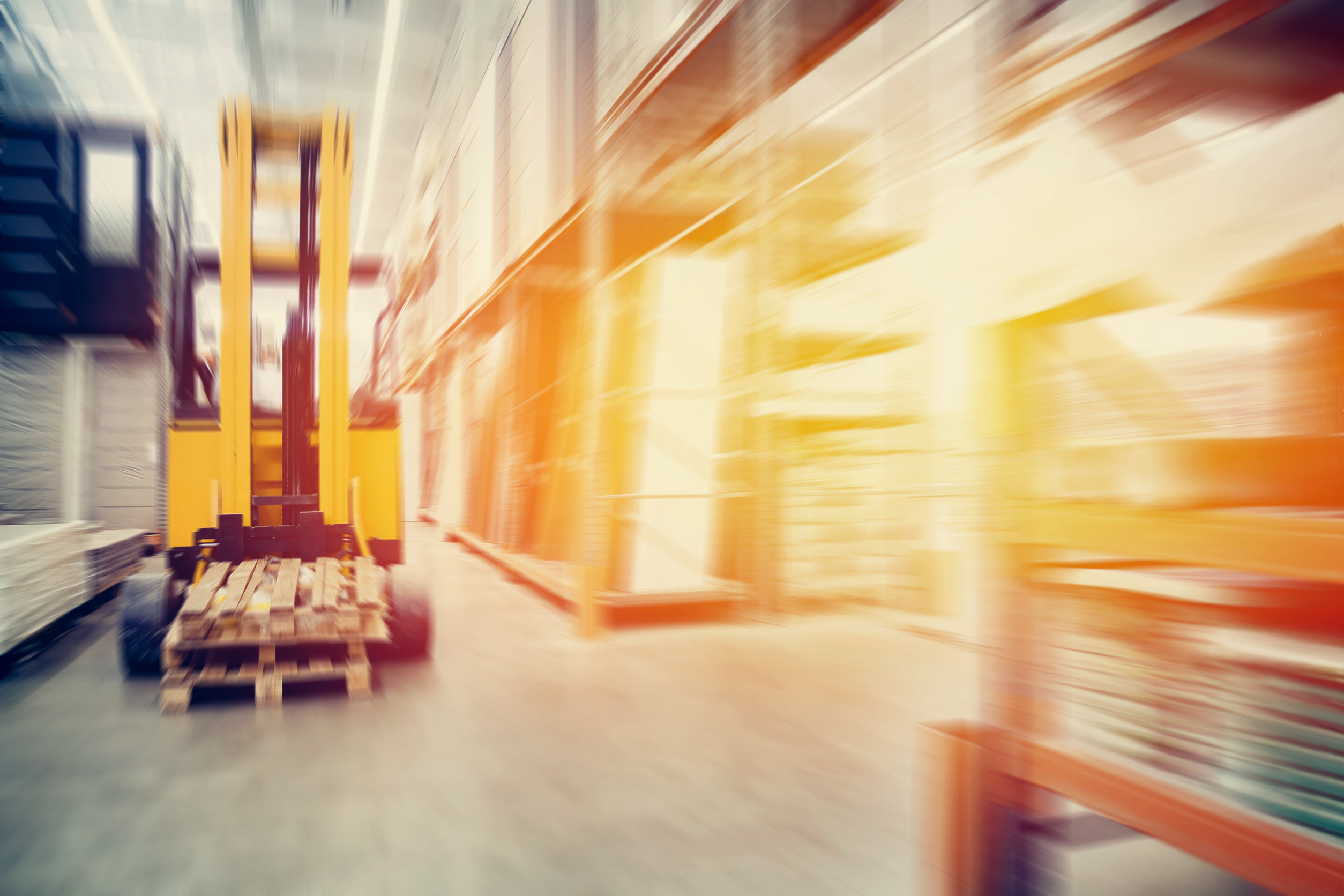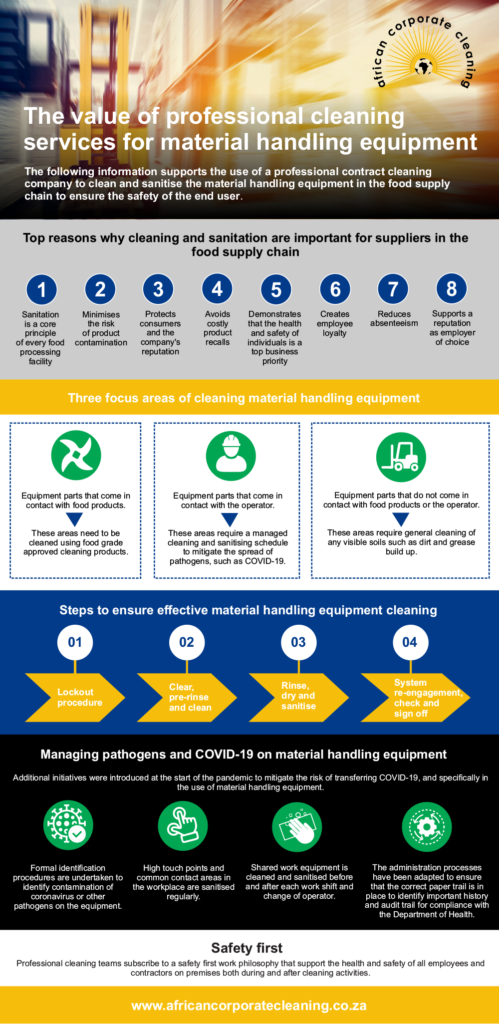The food supply chain demands quality services from all its participants to ensure the delivery of safe products for consumption by end users. Maintaining a high level of cleanliness and hygiene across the chain’s activities, including material handling, is critical to business success.
Packaged materials that are handled in the food supply chain carry lower food contamination risk than during the manufacturing and packaging processes as multiple layers of packing are already in place. But, as we know, packaging was the culprit of the transmission of listeria in the 2018 cold meat crisis in South Africa, emphasising the need to ensure that strict cleaning and sanitation standards are maintained throughout the food supply chain, even though final packaging is already in place.
Various manual, semi-automated and automated material handling equipment is used in the food supply chain to move, protect and store materials and products in the manufacturing, distribution, storage and control processes. Companies use material handling equipment that suits the types of products they supply, such as forklifts, reach trucks, pallet jacks and wheeler trolleys, to name a few. Material handling equipment, whatever kind, needs to be cleaned and sanitised regularly to maintain the required health and safety standards. This is specialised work and is often outsourced to a professional cleaning company.
The following information supports the use of a professional contract cleaning company to clean and sanitise the material handling equipment in the food supply chain to ensure the safety of the end user.
Top reasons why cleaning and sanitation are important for suppliers in the food supply chain
Effective cleaning and hygiene across the food supply chain helps ensure that all surfaces that come into direct or indirect contact with food products, including people, tools and equipment, are cleaned and sanitised regularly. This activity not only supports the safety of end users, but it ensures sustainable business relationships and on-going participation in food supply.
- Sanitation is a core principle of every food processing facility.
- Minimises the risk of product contamination.
- Protects consumers and the company’s reputation.
- Avoids costly product recalls.
- Demonstrates that the health and safety of employees, customers and consumers are top business priorities.
- Creates employee loyalty – employees that feel valued and protected have more confidence in their employers and are happier, more productive employees with less staff turnover.
- Reduces absenteeism – employees whose health and safety are prioritised operate more confidently in safe environments that reduce the risk of transferring illness.
- Supports a reputation as employer of choice.
Three focus areas of cleaning material handling equipment
Cleaning companies operate using controlled cleaning schedules and standard operating procedures to effectively clean the three main areas of material handling equipment. These include:
- The parts of the equipment that come into contact with the food products, such as the blades and lifting mechanisms. These areas need to be cleaned using food grade approved cleaning products.
- The parts of the equipment that come into contact with the operator, such as the grab handles, steering wheel, touch and display screen, control switches, levers, shared chassis areas, arm rests, safety belts, as well as access covers, battery change plugs and fuel caps, which require a managed cleaning and sanitising schedule to mitigate the spread of pathogens, such as COVID-19.
- All other parts of the equipment that do not come into contact with the food products or the operator, such as the chassis, the housing for the forklift, outer covers and wheels, which require general cleaning of any visible soils such as dirt and grease build up. The cleaning of areas such as batteries and chains should only be carried out in accordance with the specific manufacturer’s recommendations.
Guidance from the manufacturer in the operator’s manual
Professional cleaning companies cross check their cleaning schedules and standard operating procedures with the manufacturer’s operating manual. Cleaning teams undergo training to ensure that all cleaning products applied to the material handling equipment, the cleaning method, pressure and temperature all align with the recommendations by the manufacturer to ensure the best results.
Steps to ensure effective material handling equipment cleaning
The professional cleaning procedures are similar for all material handling equipment types and include the following steps:
Step 1: Lockout procedure
- The maintenance team completely shuts down the equipment and disables and disconnects any power or mechanical systems correctly.
- The maintenance team then partially or completely disassembles the system (if applicable), removing access covers and guards to support a safe and seamless cleaning process.
- Some components, like screens and belts, may need to be cleaned and, if applicable, sanitised separately.
- The lockout procedure needs to be instituted correctly and the parking brake engaged to ensure the safety of the cleaning teams as well as any individuals in the vicinity of the stationary equipment.
- Finally, signage boards are placed at the equipment confirming that the system is inoperable, confirming that the cleaning process can commence.
Step 2: Clear, pre-rinse and clean
- The cleaning team removes all visible material and food stuff before pre-rinsing the surfaces of the equipment.
- The team ensures that the pre-rinse is completed at the prescribed pressure and water temperature to eliminate all visual soil, being careful to avoid fluid ingress where applicable.
- The team applies the correct chemical or cleaning agent at the right concentration according to the manufacturer’s guidelines and cleans using the prescribed mechanical action and chemical surface contact time to ensure the best result as per the standard operating procedure.
Step 3: Rinse, dry and sanitise
- The cleaning team rinses the machine handling equipment, being careful not to direct the high-pressure nozzle at any electrical components, control panels, valves, stroke indicator labels, warning labels and/or pneumatic parts to avoid damage.
- Hand or air drying (if required) takes place, followed by sanitisation of high touch and shared contact points as specified in the standard operating procedures for the type of machine handling equipment.
- The shift supervisor checks and verifies that all the activities according to the operating procedures have been performed correctly.
Step 4: System reengagement, check and sign off
- The maintenance team reassembles the systems, replaces panels and guards and verifies that the systems are functioning properly after cleaning.
- The team double checks that all pieces have been correctly reassembled and that any clamps are tight.
- The system is run to confirm that there are no loose parts.
- Hint: It is helpful to schedule any lubrication cycles to coincide with the cleaning and sanitation cycle.
Managing pathogens and COVID-19 on material handling equipment
The coronavirus has enhanced the world’s focus on sanitation and surface cleanliness. Managing the presence of pathogens on surface areas is a key focus area of the food supply chain. Additional initiatives were introduced at the start of the pandemic to mitigate the risk of transferring COVID-19, and specifically in the use of material handling equipment.
- Formal identification procedures are undertaken to identify contamination of coronavirus or other pathogens on the equipment;
- High touch points and common contact areas in the workplace are sanitised regularly;
- Shared work equipment is cleaned and sanitised before and after each work shift and change of operator;
- Importantly, the administration processes have been adapted to ensure that the correct paper trail is in place to identify important history and audit trail for compliance with the Department of Health.
Safety first
Professional cleaning teams subscribe to a safety-first work philosophy that support the health and safety of all employees and contractors on premises both during and after cleaning activities. This involves various standard activities, such as:
- Managing slippery or wet surface areas with warning signs;
- Taking proper care using flammable chemicals, cleaning and alcohol-based sanitisation products;
- Ensuring the correct ventilation when working with harmful fumes in confined spaces;
- Being careful not to damage delicate electrical systems and controls due to exposure to high pressure, incorrect water temperatures, inappropriate chemical usage, or fluid ingress; and
- Ensuring the proper use of Personal Protection Equipment (PPE), which may include: goggles, face shields and face masks or respirators, proper clothing, gloves, aprons and/or full body suits to protect against caustic chemicals and or COVID-19, as well as non-skid, chemical-resistant footwear.
Open communications and win-win partnerships
Professional material handling equipment cleaning services help to ensure the safety of the end user and is an invaluable process in the food supply chain. However, the process can be disruptive to production.
Maintaining hygiene standards with the right cleaning partner helps to support the supply of safe, quality food. Clients should ensure that their cleaning partner complies with the criteria of ISO 22 000 and HACCP (Hazard analysis and critical control points) and that their standard operations include all the schedules and protocols to enable effective service delivery and management.
Professional cleaning companies must support their clients in finding the most optimal cleaning solution to help ensure the highest levels of productivity while meeting the health and safety criteria of food supply. This may require a combination of a flexible cleaning schedule that could include night shift cleaning, spare equipment, and open communications that allows for ad hoc changes to the cleaning schedule as and when required.
The success of the cleaning and sanitation process leans on having an open, trusting relationship with the contract cleaning company. Suppliers to the food chain should rest assured that their selected cleaning partner has experienced staff, access to extra resources if needed during audits for example, proven processes and hands on management to really provide services that support and that don’t hinder the achievement of their business objectives.
Performance guarantee – no contract required
At African Corporate Cleaning, we are so confident about solving all your needs that we will do so without any long-term contract in place. If we let you down, you just let us go. This ensures that we will always work hard at keeping you happy.
See how quickly we can help you
We have the right teams to ensure food safety at your facilities. Contact us for fast assistance: https://www.africancorporatecleaning.co.za/contact.html
African Corporate Cleaning enables confident and safe food supply.
Other services you may want more information on:


